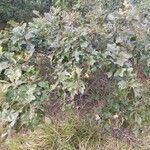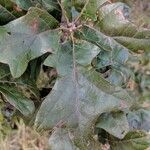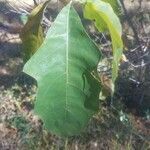Shrub or small tree to 5 m; twigs of the season thinly hairy or glabrous; lvs oblong or oblong-obovate, 5–10 cm, half or two-thirds as wide, typically with 5 short, broadly triangular lobes, occasionally with an extra pair of small lobes or with toothed lobes, closely and finely gray-tomentulose beneath; petioles 1–3 cm, glabrescent; acorns ovoid, 1.2–2 cm, the cup turbinate or deeply saucer-shaped, covering a third to half the nut, its scales relatively few and large, closely appressed. Rocky, sandy or sterile soil; s. Me. to c. N.Y., O., W.Va., and N.C.




